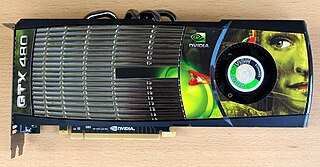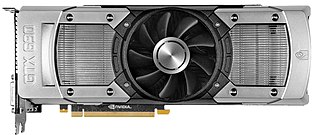
GeForce is a brand of graphics processing units (GPUs) designed by Nvidia and marketed for the performance market. As of the GeForce 40 series, there have been eighteen iterations of the design. The first GeForce products were discrete GPUs designed for add-on graphics boards, intended for the high-margin PC gaming market, and later diversification of the product line covered all tiers of the PC graphics market, ranging from cost-sensitive GPUs integrated on motherboards to mainstream add-in retail boards. Most recently, GeForce technology has been introduced into Nvidia's line of embedded application processors, designed for electronic handhelds and mobile handsets.

The GeForce 256 is the original release in Nvidia's "GeForce" product line. Announced on August 31, 1999 and released on October 11, 1999, the GeForce 256 improves on its predecessor by increasing the number of fixed pixel pipelines, offloading host geometry calculations to a hardware transform and lighting (T&L) engine, and adding hardware motion compensation for MPEG-2 video. It offered a notable leap in 3D PC gaming performance and was the first fully Direct3D 7-compliant 3D accelerator.

The GeForce FX or "GeForce 5" series is a line of graphics processing units from the manufacturer Nvidia.

The GeForce 2 series (NV15) is the second generation of Nvidia's GeForce line of graphics processing units (GPUs). Introduced in 2000, it is the successor to the GeForce 256.

The GeForce 4 series refers to the fourth generation of Nvidia's GeForce line of graphics processing units (GPUs). There are two different GeForce4 families, the high-performance Ti family, and the budget MX family. The MX family spawned a mostly identical GeForce4 Go (NV17M) family for the laptop market. All three families were announced in early 2002; members within each family were differentiated by core and memory clock speeds. In late 2002, there was an attempt to form a fourth family, also for the laptop market, the only member of it being the GeForce4 4200 Go (NV28M) which was derived from the Ti line.

The GeForce 6 series is the sixth generation of Nvidia's GeForce line of graphics processing units. Launched on April 14, 2004, the GeForce 6 family introduced PureVideo post-processing for video, SLI technology, and Shader Model 3.0 support.
Core Image is a pixel-accurate, near-realtime, non-destructive image processing technology in Mac OS X. Implemented as part of the QuartzCore framework of Mac OS X 10.4 and later, Core Image provides a plugin-based architecture for applying filters and effects within the Quartz graphics rendering layer. The framework was later added to iOS in iOS 5.

The GeForce 7 series is the seventh generation of Nvidia's GeForce line of graphics processing units. This was the last series available on AGP cards.
The GeForce 8 series is the eighth generation of Nvidia's GeForce line of graphics processing units. The third major GPU architecture developed by Nvidia, Tesla represents the company's first unified shader architecture.
The GeForce 9 series is the ninth generation of Nvidia's GeForce line of graphics processing units, the first of which was released on February 21, 2008. The products are based on an updated Tesla microarchitecture, adding PCI Express 2.0 support, improved color and z-compression, and built on a 65 nm process, later using 55 nm process to reduce power consumption and die size.

The GeForce 200 series is a series of Tesla-based GeForce graphics processing units developed by Nvidia.
Nvidia Ion was a product line of Nvidia Corporation intended for motherboards of low-cost portable computers. It used graphics processing units and chipsets intended for small products.
The GeForce 300 series is a series of Tesla-based graphics processing units developed by Nvidia, first released in November 2009. Its cards are rebrands of the GeForce 200 series cards, available only for OEMs. All GPUs of the series support Direct3D 10.1, except the GT 330.

The GeForce 400 series is a series of graphics processing units developed by Nvidia, serving as the introduction of the Fermi microarchitecture. Its release was originally slated in November 2009, however, after delays, it was released on March 26, 2010, with availability following in April 2010.
The GeForce 500 series is a series of graphics processing units developed by Nvidia, as a refresh of the Fermi based GeForce 400 series. It was first released on November 9, 2010 with the GeForce GTX 580.

The GeForce 600 series is a series of graphics processing units developed by Nvidia, first released in 2012. It served as the introduction of the Kepler architecture. It is succeeded by the GeForce 700 series.

The GeForce 700 series is a series of graphics processing units developed by Nvidia. While mainly a refresh of the Kepler microarchitecture, some cards use Fermi (GF) and later cards use Maxwell (GM). GeForce 700 series cards were first released in 2013, starting with the release of the GeForce GTX Titan on February 19, 2013, followed by the GeForce GTX 780 on May 23, 2013. The first mobile GeForce 700 series chips were released in April 2013.

The GeForce 900 series is a family of graphics processing units developed by Nvidia, succeeding the GeForce 700 series and serving as the high-end introduction to the Maxwell microarchitecture, named after James Clerk Maxwell. They were produced with TSMC's 28 nm process.

The GeForce 10 series is a series of graphics processing units developed by Nvidia, initially based on the Pascal microarchitecture announced in March 2014. This design series succeeded the GeForce 900 series, and is succeeded by the GeForce 16 series and GeForce 20 series using the Turing microarchitecture.













